人教版高一英语必修三 unit 3_教案
新人教高中英语必修三Unit3 DiverseCultures-Readingforwrting教案
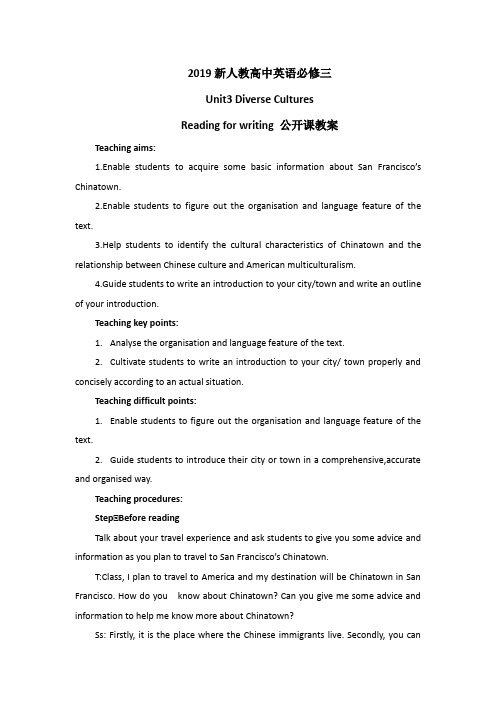
2019新人教高中英语必修三Unit3 Diverse CulturesReading for writing 公开课教案Teaching aims:1.Enable students to acquire some basic information about San Francisco’s Chinatown.2.Enable students to figure out the organisation and language feature of the text.3.Help students to identify the cultural characteristics of Chinatown and the relationship between Chinese culture and American multiculturalism.4.Guide students to write an introduction to your city/town and write an outline of your introduction.Teaching key points:1.Analyse the organisation and language feature of the text.2.Cultivate students to write an introduction to your city/ town properly and concisely according to an actual situation.Teaching difficult points:1.Enable students to figure out the organisation and language feature of the text.2.Guide students to introduce their city or town in a comprehensive,accurate and organised way.Teaching procedures:StepⅠBefore readingTalk about your travel experience and ask students to give you some advice and information as you plan to travel to San Francisco’s Chinatown.T:Class, I plan to travel to America and my destination will be Chinatown in San Francisco. How do you know about Chinatown? Can you give me some advice and information to help me know more about Chinatown?Ss: Firstly, it is the place where the Chinese immigrants live. Secondly, you canexplore the interesting sights,experience traditional Chinese culture, go shopping, eat Chinese food, and so on.Step ⅠWhile readingCultural NoteThe Dragon Gate is the most photographed site in San Francisco’s Chinatown.The gate was designed by three Chinese-American architects in 1967 using traditional Chinese village gates for inspiration.The Tin How Temple is the oldest Taoist temple in Chinatown,and one of the oldest Chinese temples in the United States.The temple was built in 1852,but then destroyed by the 1906 earthquake.The image of the goddess Mazu was preserved,as well as part of the altar and the bell.These were relocated to the top floor of a building constructed on the site of the old temple.The Bank of Canton is actually the old Chinese Telephone Exchange,a traditional Chinese-style building constructed in 1894.When the telephone was first introduced,there was no way to dial a number.Instead,you would have to talk to a switchboard operator (nearly always a woman),tell her the telephone number of the person you wanted to talk to,and she would manually connect you to the person you wanted to call using an electric plug.However,Chinese residents thought it was impolite to use a number to refer to a person,so the switchboard operators in Chinatown had to know all the names and addresses of everyone in Chinatown so they would know who to connect people to.They also had to know five dialects of Chinese and speak English.Like many buildings in Chinatown,the Chinese Telephone Exchange was destroyed by the 1906 earthquake,but it was quickly rebuilt.However,in 1949 it was closed when dial telephones made switchboards unnecessary.Portsmouth Square,now a public park,is the site of San Francisco’s first public square,built in the early 19th century.While many important historical events related to California and San Francisco occurred in the square before Chinatown was established or grew in size,the site is now very much considered an integral part of Chinatown.The Scottish novelist Robert Louis Stevenson (1850—1894) lived in San Francisco briefly between 1879—1880,and spent much time in Portsmouth Square during his stay there.There is a monument in his honour in the park.Activity 1Prediction1.Look at the title and picture and predict what kind of article is this?2.Who are the target readers?3.What is the writer’s purpose of writing this text?Suggested answers:1.This is an introduction to Chinatown in San Francisco.2.Visitors.3.To introduce a diverse cultural Chinatown in San Francisco to visitors.Activity 2 Reading for main ideaRead the text quickly and match the main idea of the passage.Para.1 A.The characteristic of Chinatown.Para.2 B.The history of Chinatown.Para.3 C.The introduction of Chinatown’s shops and products.Para.4 D.The origin of Chinatown.Para.5 E.The existence value of Chinatown.Para.6 F.The famous food and drinks of Chinatown.Suggested answers:Para.1:A Para.2:D Para.3:B Para.4:C Para.5:F Para.6:EActivity 3 Reading for detailsRead the passage again and answer the questions.1.What are the famous tourist sites in the Chinatown of San Francisco?2.Which is the best season to visit the Chinatown in San Francisco?3.What else can you do there?Suggested answers:1.Dragon Gate,Tin How Temple,Bank of Canton,and Portsmouth Square.2.All year round.3.We can explore the interesting sights,experience traditional Chinese culture,goshopping,eat Chinese food,and so on.Activity 4Reading for organisation and language featuresRead the text again and study the organisation and language feature.1.What information is included in the introduction? Tick the items that are mentioned.2.Underline the sentences that are used to describe the items above.Location:______________________Climate:________________________________History:_____________________________________Ethnic groups:____________________________________Languages:_____________________________________________Famous figures:_____________________________________________Famous food/drink:_______________________________________________ Tourist attractions:_________________________________________________ Businesses and industries:_____________________________________________3.Fill in the blanks to show the structure of the text.Paragraph(s)Main ideaDetails Expressions1 Introductionsh ortintrodu ction to San Francisc o’s Chinato wn2—5 Bodywhat youcan findand doin San Francisco’sChina-town23456 Summaryim portanc e of Chinato wnSuggested answers: 1.2.Location:in San FranciscoClimate:mild all year roundHistory:Chinese immigrants settled in the area during the railroad construction and gold rush periodEthnic groups:the majority of residents in Chinatown are still ethnic ChineseLanguages:many of whom do not speak English fluentlyFamous figures:Robert LouisFamous food/drink:traditional dishes from all over ChinaTourist attractions:Dragon Gate,Tin How Temple,Bank of Canton,Portsmouth SquareBusinesses and industries:souvenirs,goods,and clothing;all kinds of traditional Chinese herbal medicine;Chinese tea stores3.Pa ragraph (s)MainideaDetails Expressions1Int roducti onshortintroduction toSanFrancisco’sChinatownlocation,features,climatebiggest,oldest,very popular tourist draw,mild allyear round2—5what you2history,ethnichistorically...what started as...then turnedinto...the majority of residents...a real taste of ChinaBo dy canfindand doin SanFrancisco’sChinatowngroups,language3attractions,famous figuresfamous sites include....to name but a few,spendhours just exploring the interesting sights,smells,andsounds of China,a key site.a great place to...4storesand goodsoffer a unique range of...all kinds of...can befound,varieties of5foodtreasure,suit everyone’s taste,traditional dishesfrom all over China6 Summa ryimportance ofChinatownuniquecultureallow...to...experience...first handStepⅠ Describing a place with distinctive cultural identity1.In groups,brainstorm as much information as possible about your city/town and its culture.Then write an outline of your introduction.①What is unique about your city/town?②Is it a city/town with diverse cultures?③What examples can you give to illustrate its feature?2.Write an introduction to your city/town.The following phrases and expressions may help you.·is located in/on·has a history of...years·is divided up into·has a population of·is...in size·is home to...ethnic groups·the most popular/greatest/largest·popular festivals/foods/tourist sights include...Suggested answers:1.①My city is distinctive cultural identity.②Yes,it is a city/town with diverse cultures.③I will give examples such as history,population...to illustrate its features.2.Lijiang is an ancient city high up in the mountains of Yunnan,near the borders of Sichuan and Tibet.It was an important stop on the Ancient Tea and Horse Road,which connected central China with Myanmar and India,transporting not just tea but also silk and other goods.Lijiang’s Old Town,with a history of over 800 years,is a UNESCO World Heritage Site.Today,Lijiang is mostly known for its ethnic minority culture,especially the culture of the Naxi ethnic group.The Naxi are famous for their Dongba culture.They have their own unique written language that uses pictures and symbols.They also create beautiful arts and crafts,and are well known for their singing and dancing.Strolling around the Old Town,one can witness Naxi life much as it was hundreds of years ago.One can also try traditional Naxi food,including the air-dried pork liver,Naxi baba (a kind of flat bread),and Naxi hot pot.But if you really want to see Naxi traditional culture,it is best to visit during the Torch Festival,which usually occurs in the summer.During the festival,the streets are full of torches,bonfires,and lots of people singing and dancing.While the main ethnic group living in the area is the Naxi,there are also at least 19 other ethnic groups,including Yi,Lisu,Bai,Tibetan,and Pumi.It is easy to arrange a short homestay with an ethnic minority family to learn more about their way of life.Just outside the city,there are beautiful mountains,meadows,lakes,rivers,and gorges,offering plenty of opportunities to go hiking,kayaking,or rafting.Like much of Yunnan,the weather is always fairly mild in Lijiang,so it is fine to visit throughout the year.Lijiang can be easily reached by airplane or train,and visitors can hire bikes or cars to explore the area.It is the perfect place for tourists to experience the colourful culture of China’s ethnic minorities.StepⅠEvaluating and polishing the draft1.Exchange drafts with a e the checklist to give feedback on your partner’s draft.2.Get your draft back and revise it.3.Put up your introduction in your classroom or share it with the class.StepⅠHomework书面表达:请阅读下面有关中国题材纪录片(documentary)的对话,并按照要求用英语写一篇150个词左右的文章。
人教版高中英语必修3《unit3》精品课件.
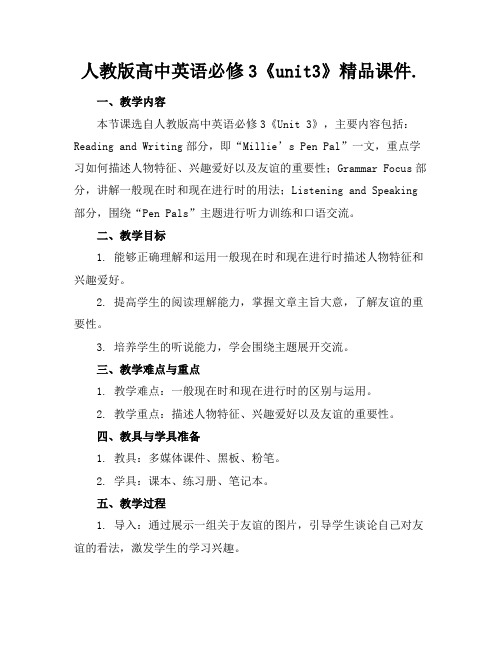
人教版高中英语必修3《unit3》精品课件.一、教学内容本节课选自人教版高中英语必修3《Unit 3》,主要内容包括:Reading and Writing部分,即“Millie’s Pen Pal”一文,重点学习如何描述人物特征、兴趣爱好以及友谊的重要性;Grammar Focus部分,讲解一般现在时和现在进行时的用法;Listening and Speaking 部分,围绕“Pen Pals”主题进行听力训练和口语交流。
二、教学目标1. 能够正确理解和运用一般现在时和现在进行时描述人物特征和兴趣爱好。
2. 提高学生的阅读理解能力,掌握文章主旨大意,了解友谊的重要性。
3. 培养学生的听说能力,学会围绕主题展开交流。
三、教学难点与重点1. 教学难点:一般现在时和现在进行时的区别与运用。
2. 教学重点:描述人物特征、兴趣爱好以及友谊的重要性。
四、教具与学具准备1. 教具:多媒体课件、黑板、粉笔。
2. 学具:课本、练习册、笔记本。
五、教学过程1. 导入:通过展示一组关于友谊的图片,引导学生谈论自己对友谊的看法,激发学生的学习兴趣。
2. 阅读理解:让学生阅读“Millie’s Pen Pal”一文,完成相应的练习题,掌握文章大意,了解友谊的重要性。
3. 语法讲解:结合文章内容,讲解一般现在时和现在进行时的用法,并通过例句进行巩固。
4. 听力训练:播放听力材料,让学生完成相关练习,提高听力水平。
5. 口语交流:组织学生进行小组讨论,围绕“Pen Pals”主题展开口语交流,培养学生的口语表达能力。
6. 随堂练习:设计相关练习题,让学生当堂巩固所学知识。
六、板书设计1. 文章Millie’s Pen Pal2. 语法重点:一般现在时、现在进行时3. 课堂练习:描述人物特征、兴趣爱好七、作业设计1. 作业题目:(1)用一般现在时和现在进行时描述你的好朋友。
(2)围绕“Pen Pals”主题,写一篇短文,介绍你的笔友。
人教版高一英语必修3Unit 3教学设计教案
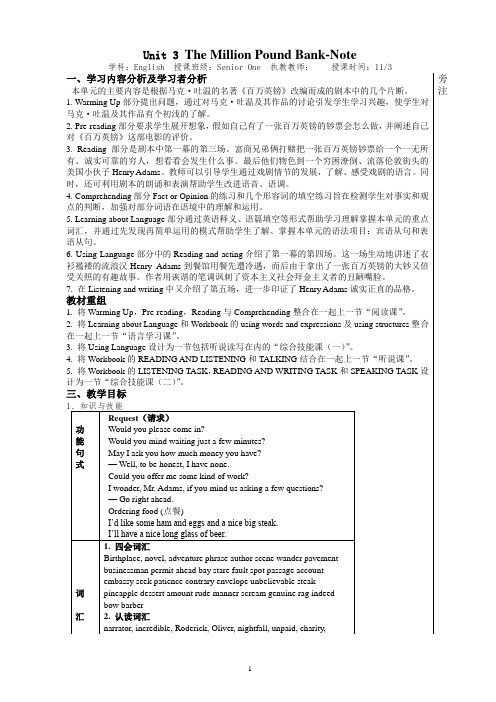
Unit 3 The Million Pound Bank-Note学科:English 授课班级:Senior One 执教教师:授课时间:11/3一、学习内容分析及学习者分析本单元的主要内容是根据马克·吐温的名著《百万英镑》改编而成的剧本中的几个片断。
1. Warming Up部分提出问题,通过对马克·吐温及其作品的讨论引发学生学习兴趣,使学生对马克·吐温及其作品有个初浅的了解。
2. Pre-reading部分要求学生展开想象,假如自己有了一张百万英镑的钞票会怎么做,并阐述自己对《百万英镑》这部电影的评价。
3. Reading部分是剧本中第一幕的第三场。
富商兄弟俩打赌把一张百万英镑钞票给一个一无所有、诚实可靠的穷人,想看看会发生什么事。
最后他们物色到一个穷困潦倒、流落伦敦街头的美国小伙子Henry Adams。
教师可以引导学生通过戏剧情节的发展,了解、感受戏剧的语言。
同时,还可利用剧本的朗诵和表演帮助学生改进语音、语调。
4. Comprehending部分Fact or Opinion的练习和几个形容词的填空练习旨在检测学生对事实和观点的判断,加强对部分词语在语境中的理解和运用。
5. Learning about Language部分通过英语释义、语篇填空等形式帮助学习理解掌握本单元的重点词汇,并通过先发现再简单运用的模式帮助学生了解、掌握本单元的语法项目:宾语从句和表语从句。
6. Using Language部分中的Reading and acting介绍了第一幕的第四场。
这一场生动地讲述了衣衫褴褛的流浪汉Henry Adams到餐馆用餐先遭冷遇,而后由于拿出了一张百万英镑的大钞又倍受关照的有趣故事。
作者用诙谐的笔调讽刺了资本主义社会拜金主义者的丑陋嘴脸。
7. 在Listening and writing中又介绍了第五场,进一步印证了Henry Adams诚实正直的品格。
人教版高中英语必修三unit3教案

Unit 3 The Million Pound NotesTeaching aims and demands1. topic: 1) Forms of literature and art: short story and drama2) Space travel and gravity2. function: 1)Request2)Ordering food3. vocabulary: words and expressions unit 34. grammar: Noun clauses as the object and predicative Period 1 Vocabulary1. bet n. 赌;打赌v. 打赌;赌钱[典例]1) . He often bets a 1ot of money on horses.他经常在赛马上豪赌。
2) . I bet that it will rain tomorrow. 我敢肯定说明天一定会下雨。
[重点用法]bet on为某事打赌make a bet on 为某事打赌win/lose a bet 打赌赢/输了[练习]按要求翻译。
1) _________ .We _ _____ _____ 打(赌)the outcome of the next horserace.2) .他把所有的钱都用在赌马上Keys: 1). make a bet on 2). He spends all his money betting on horses.2. fault n. 缺点;错误,过错;故障vt.挑剔,指责faulty adj.有缺点的;不完善的faultless adj.不可挑剔的[典例]1). I like him despite his faults. 虽然他有种种缺点, 但我仍然喜欢他。
2). No one could fault his performance. 他的演出无懈可击。
人教版必修三英语第三单元教案TalkingaboutPhysicalAppearance
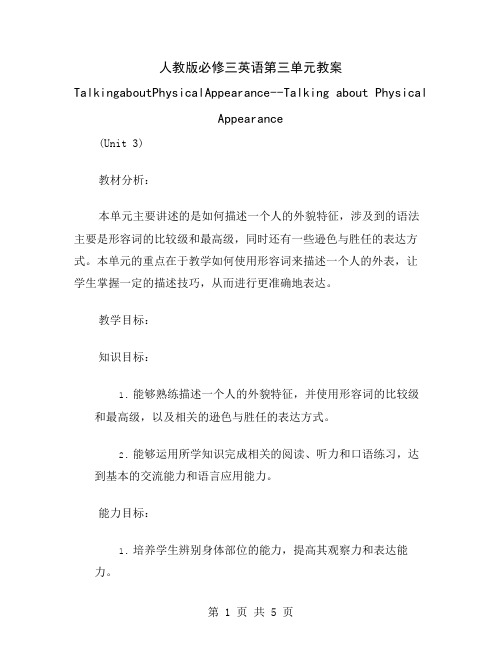
人教版必修三英语第三单元教案TalkingaboutPhysicalAppearance--Talking about PhysicalAppearance(Unit 3)教材分析:本单元主要讲述的是如何描述一个人的外貌特征,涉及到的语法主要是形容词的比较级和最高级,同时还有一些逊色与胜任的表达方式。
本单元的重点在于教学如何使用形容词来描述一个人的外表,让学生掌握一定的描述技巧,从而进行更准确地表达。
教学目标:知识目标:1.能够熟练描述一个人的外貌特征,并使用形容词的比较级和最高级,以及相关的逊色与胜任的表达方式。
2.能够运用所学知识完成相关的阅读、听力和口语练习,达到基本的交流能力和语言应用能力。
能力目标:1.培养学生辨别身体部位的能力,提高其观察力和表达能力。
2.提高学生的英语听、说、读、写的能力,使其能够流利地进行英语口语交流。
情感目标:1.培养学生树立正确的审美观和人生价值观,使其能够尊重不同的文化和不同的人。
2.鼓励学生在语言学习中发扬创新思维,锻炼自我表达的勇气和能力。
教学重点:1.形容词比较级、最高级和逊色与胜任的表达方式的掌握。
2.学生口语表达能力的培养和提高。
教学难点:1.如何正确运用形容词比较级、最高级和逊色与胜任的表达方式。
2.如何培养学生英语口语表达的能力,提高其英语听、说、读、写的能力教学设计:一.课前准备 ( Pre-task preparation)1.教师准备相关的物品,以便于学生在描述一个人的外貌时有具体的东西可以参考。
2.让学生阅读相关的课文,了解相关的语言点和表达方式。
二.引入 (Introduction)1.教师可以通过播放一段视频或者是展示图片,引入对话题的思考。
2.教师可以介绍一些有趣的人物,引入本节课的主要内容。
三.新课教学 (New content)1.形容词的比较级和最高级 (Comparative and superlative adjectives)a.讲解基本的用法和规则。
人教版英语必修三Unit 3(Reading)教案

The Million Pound Bank Note – Reading 教案Teaching Contents: Unit 3 The Million Pound Bank Note (Reading)(高中英语必修三第三单元17页The Million Pound Bank Note课文阅读部分)Teaching Objectives:●Knowledge Objectives1. To learn some new words and expressions.2. To ensure the students have a full understanding of this passage.3. To let the students know more background information about the play and Mark Twain.●Ability Objectives1. To improve the students’ reading ability through reading activities.2. To get the students to learn different reading skills.●Moral Objectives1. To arouse the students’ interest in foreign literature.2. To cultivate the students’ ability and awareness of cooperation.Teaching Important Points:1. To make the students have a full understanding of this passage.2. To improve the students’ reading ability through reading activities.Teaching Difficult Points:1 .To help the students understand the passage better.2. To improve the students’ reading ability in different ways.Teaching Methods:1. Task-based method2. Discussing method2. Fast reading3. Careful readingTeaching Aids:1. Multi-media facilities2. A blackboard3. Textbook and Exercise booksTeaching procedures:Step I Greeting and leading in (6 minutes)1. Greeting2. Watch a short video about Mark Twain. (Ask the students to pay attention to the details about Mark Twain.)3. Tell something about Mark Twain.Step II Fast Reading (10 minutes)1.Ask the students to read the first paragraph quickly and find the time and the maincharacters of this passage.2.Ask the students to scan the whole passage and choose the best answers.3.Teacher guide the students how to find the answers.StepⅢCareful Reading (20 minutes)1. Ask the students to read the whole passage carefully and try to answer the given questions.2. Ask the students to read the passage and put the following statements in the correct order according to the development of the story. (Ask the students to discuss it with their desk mates) 同步训练第38页3.Ask the students to read the passage and try to write down the main idea of the passage. (Fill in the blanks)StepⅣ Summary (8 minutes)1.Ask the students to finish the exercise in the exercise book. (一线精练第17页)2.Teacher gives the answers and correct.Step ⅤHomework (1 minute)1. Think about what kind of person Henry was? Give at least two reasons.2. Can you guess the following story? Write at least 5 sentences.。
高中英语人教版必修3Unit3全单元教案设计

高中英语人教版必修3Unit3全单元教案设计Unit 3The Million Pound Bank Note单元规划类别课程标准要求掌握的项目话题Forms of literature and art: short story and drama; how to act out a play词汇birthplacen.出生地; 故乡Embassy n. 大使馆; 大使及其官员phrasen.短语; 词组; 惯用语Seek vt. & vi. 寻找; 探索; 寻求adventure n. 奇遇; 冒险patience n. 耐性; 忍耐novel n.小说; 长篇故事adj. 新奇的; 异常的contrary n. 反面; 对立面adj. 相反的;相违的authorn.著者; 作家Envelope n. 信封scenen.(戏剧)一场; 现场; 场面;景色Permit vt. & vi. 许可; 允许; 准许n. 通行证; 许可证; 执照wander vi. 漫游; 漫步; 漂泊steak n. 肉块; 鱼排; 牛排pavement n. 人行道pineapple n. 菠萝businessman n. 商人dessert n. 餐后甜点unbelievable adj. 难以置信的amount n. 数量aheadad v. 在前; 向前; 提前rude adj. 粗鲁的; 无礼的bayn.海湾mannern.礼貌; 举止; 方式stare vi. 凝视; 盯着看scream vi. 尖声叫n. 尖叫声; 喊叫声fault n. 过错; 缺点; 故障genuine adj. 真的; 真诚的bow vi. & n. 鞠躬; 弯腰rag n. 破布; 碎布passage n. 船费; 通道; (一)段indeed adv. 真正地; 确实; 实在account vt. & vi. 认为; 说明; 总计有n. 说明; 理由; 计算;账目spot vt. 发现; 认出n. 斑点; 污点;地点短语bring up抚养; 培养; 教育; 提出in rags衣衫褴褛go ahead 前进; (用于祈使句)可以; 往下说as for关于; 至于by accident偶然; 无意中; 不小心do with对待; 处理; 处置stare at盯着看; 凝视make a bet打赌account for导致; 做出解释be lost迷路; 倾心于某事on the contrary与此相反; 正相反permit sb. to do sth. 准许某人做某事take a chance冒风险; 碰运气in a. . . manner以……的举止(态度)重要句型1. Young man, would you step inside a moment, please? (request)2. I wonder, Mr. Adams, if you’d mind us asking a few questions. (I wonder if. . . )3. . . . I found myself carried out to sea by a strong wind. (find+O. +O. C. )4. And it was the ship that brought you to England. (it is/was. . . that. . . )5. The fact is that I earned my passage by working as an unpaid hand. . . (noun clause as thepredicative)6. You mustn’t think we don’t care about you. (double negative)7. That’s why we’ve given you the letter. (noun clause asthe predicative)8. Well, why don’t you explain what this is all about?(suggestion; noun clause as the object)功能 1. RequestWould you please come in?Could you offer me some kind of work?Would you mind waiting just a few minutes?I wonder, Mr. Adams, if you mind us asking a few questions? May I ask you how much money you have?—Well, to be honest, I have none.—Go right ahead.2. Ordering foodI’d like some ham and eggs and a nice big steak.I’ll have a nice long glass of beer.3. Shopping语法 1. Noun clauses as the objectI can’t say that I have any plans.. . . and he does not know what he should do.。
(完整版)人教版高中英语必修三第三单元教案
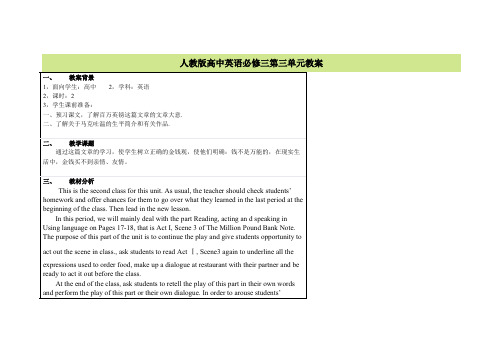
interest, the teacher can hold a competition among them.教学重点1. Develop students’ reading and speaking skills.2. Let students read and act the play.3. Have students learn to use the expressions t o order food.教学难点1. Enable students to learn to use reading strategies such as skimming, scanning, and so on.2. Get students to act the play.3. Have students make a dialogue at the restaurant.三维目标知识与技能目标1. Get students to learn some useful new words and expressions in this part.2. Get students to read the play.3. Let students learn the expressions of ordering food.过程与方法目标1. Develop students’ reading skills and enable them to learn how to use different reading strategies to read different reading materials.2. Enable student s to understand and act out the play.3. Have students learn how to use the expressions to order food.情感态度与价值观目标1. Stimulate students’ interests of learning English by reading and acting this play.2. Develop students’ sense of group cooperation and teamwork.四、教学方法Problems probing method. Work in groupsMake a quiz for the students to find out how much they already know about Mark Twain, Ask students to answer questions by groups. The questions are as follows:1.What was the real name of Mark Twain?2.What was his job?3.Can you name one of his famous novels?五、教学过程→Step 1 Revision1. Check the homework exercises.2. Ask some students to read the words of U3.→Step 2 Warming up1. Ask students to make a list of all the changes that Henry has made to his life.2. Have them in pairs discuss what difference they think this will make to the way people treat him and report their ideas to the class.3. Learn more about Mark Twain. Then list some popular novels such as The Adventures of TomSawyer, The Prince and the Pauper. [百度知道]→Step 3 Brief introduction of The million pound note[百度知道]Step 4 listen to the tape1. Ask the all turn to Page 17. We are going to listen to ActⅠ, Scene 3.2. Let them listen carefully and write down the main idea.3. Play the tape again to check and have the correct answers.→Step 5 Reading and speaking task1. Ask students to discuss the following questions in pairs.1) Where did Henry come from?2) Why was Henry in London?3) What happened to Henry?→Step5 See the movie [百度知道]Let a group retell the story and start a role play.→Step 6 Think overDo you know the exchange rate between pound and RMB?[百度知道]→Step 6 Homework1. Finish the Workbook exercises.2. Review the contents of the unit and complete Summing Up on Page 24.六、教学反思这篇课文很有挖掘、开发的价值,通过the waiter和老板的语言、动作、神态等描写,细致刻画出两个市井人物的见钱眼开、惟利是图的丑恶嘴脸。
必修三英语unit3教案
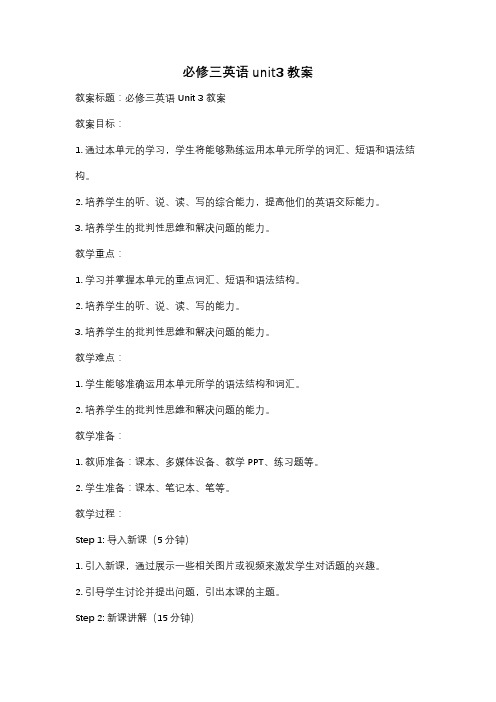
必修三英语unit3教案教案标题:必修三英语 Unit 3 教案教案目标:1. 通过本单元的学习,学生将能够熟练运用本单元所学的词汇、短语和语法结构。
2. 培养学生的听、说、读、写的综合能力,提高他们的英语交际能力。
3. 培养学生的批判性思维和解决问题的能力。
教学重点:1. 学习并掌握本单元的重点词汇、短语和语法结构。
2. 培养学生的听、说、读、写的能力。
3. 培养学生的批判性思维和解决问题的能力。
教学难点:1. 学生能够准确运用本单元所学的语法结构和词汇。
2. 培养学生的批判性思维和解决问题的能力。
教学准备:1. 教师准备:课本、多媒体设备、教学PPT、练习题等。
2. 学生准备:课本、笔记本、笔等。
教学过程:Step 1: 导入新课(5分钟)1. 引入新课,通过展示一些相关图片或视频来激发学生对话题的兴趣。
2. 引导学生讨论并提出问题,引出本课的主题。
Step 2: 新课讲解(15分钟)1. 教师通过PPT或黑板等方式,讲解本单元的重点词汇、短语和语法结构。
2. 结合例句和实际情境,帮助学生理解和记忆新知识。
Step 3: 听说训练(20分钟)1. 播放相关录音或视频材料,让学生进行听力训练。
2. 设计一些与课文内容相关的口语练习,让学生进行对话练习。
Step 4: 阅读训练(20分钟)1. 学生独立阅读课文,理解文章的大意和细节。
2. 学生进行小组讨论,分享自己的理解和观点。
3. 教师组织全班讨论,引导学生深入思考课文中的问题和主题。
Step 5: 写作训练(15分钟)1. 学生根据课文内容,完成相关写作任务,如写一篇短文、写一封信等。
2. 学生互相交流和修改自己的作文,提高写作质量。
Step 6: 巩固练习(15分钟)1. 教师设计一些练习题,让学生巩固所学的语法和词汇。
2. 学生独立完成练习,并相互检查答案。
Step 7: 课堂总结(5分钟)1. 教师对本节课的内容进行总结,并强调重点和难点。
人教版高中英语必修3 Unit3 Reading 优秀教学设计(一)
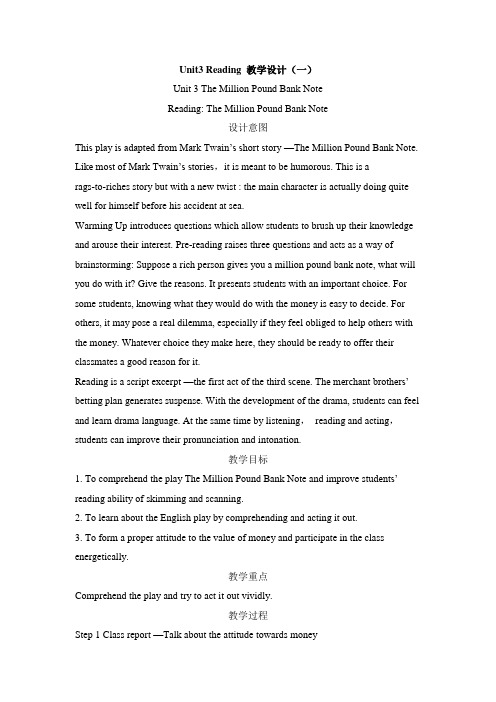
Unit3 Reading 教学设计(一)Unit 3 The Million Pound Bank NoteReading: The Million Pound Bank Note设计意图This play is adapted from Mark Twain’s short story —The Million Pound Bank Note. Like most of Mark Twain’s stories,it is meant to be humorous. This is arags-to-riches story but with a new twist : the main character is actually doing quite well for himself before his accident at sea.Warming Up introduces questions which allow students to brush up their knowledge and arouse their interest. Pre-reading raises three questions and acts as a way of brainstorming: Suppose a rich person gives you a million pound bank note, what will you do with it? Give the reasons. It presents students with an important choice. For some students, knowing what they would do with the money is easy to decide. For others, it may pose a real dilemma, especially if they feel obliged to help others with the money. Whatever choice they make here, they should be ready to offer their classmates a good reason for it.Reading is a script excerpt —the first act of the th ird scene. The merchant brothers’ betting plan generates suspense. With the development of the drama, students can feel and learn drama language. At the same time by listening,reading and acting,students can improve their pronunciation and intonation.教学目标1. To comprehend the play The Million Pound Bank Note and improve s tudents’ reading ability of skimming and scanning.2. To learn about the English play by comprehending and acting it out.3. To form a proper attitude to the value of money and participate in the class energetically.教学重点Comprehend the play and try to act it out vividly.教学过程Step 1 Class report —Talk about the attitude towards money(设计意图: 通过“课前汇报”的形式,引出本堂课的话题,同时检查学生课前自主学习的效果。
人教版高中英语必修三Unit3Reading教案全面版

⼈教版⾼中英语必修三Unit3Reading教案全⾯版Unit3 Reading精品教案Period 1 & 2Pre-reading, Reading & ComprehendingTeaching objectives:1. To talk about short stories and plays.2. To develop Ss’ reading skills.3. To arouse Ss’ interest in acting out a play and writing a play.Teaching Procedures:Step 1. Pre-readingPurpose:To arouse Ss’ interest in learning about the attitudes of different people.1. Show some pictures and encourage Ss to get as much information as possible. Then ask them to answer the following questions.(1) When you get a large amount of money to use as you like, what will you do with it? Why?(2) Have you ever made a bet with a friend? If so, what did you bet on?(3) How did you feel about the bet after it was won or lost?(4) Have you ever rea d the story “The Million Pound Bank-Note”?(5) Have you seen the movie? If so, what did you think of it?2. Get Ss to talk freely with their partners about the value and use of money. After talking, ask Ss to present their opinions in class.For Your Reference:S1: I’ll buy a big house, a new car of my own and get married to a beautiful girl. In my opinion, the most important thing for a person is to enjoy the life. So, if I have a lot of money, I’ll make full use of it to meet my needs for a rich life. S2: I’ll give some money of the one million pound to the poor people in the western part of our country to help them live a happy life, especially the children.Because they really need help and they can learn more knowledge in order to develop the western part of our country. This way of spending money ismeaningful.S3: ...Step 2. Leading-inPurpose:To stimulate Ss’ interest in reading the text.Ask Ss to think about the following questions and talk about the answers.1. How did Henry get the Million Pound Bank-Note?2. Do you agree that the money can bring Henry happiness?3. What will Henry do with the note?4. How many characters are there in this scene?5. When and where did the story happen?Step 3. Fast readingPurpose: To get the gist of the passage.1. Ask Ss to read the text quickly and try to get the main idea of the text.2. Ask Ss to finish the following exercises according to the text.(1) Which is the right order of the events according to the text?① Henry wandered in London streets.② About a month ago, Henry Adams was sailing out of the bay.③ The next morning he was spotted by a ship.④ Towards nightfall he found himself carried out to sea by a strong wind.⑤ On the ship he earned his passage by working as an unpaid hand.A. ①②③④⑤B. ②③④⑤①C. ②④③①⑤D. ②④③⑤①(2) What’s the servant’s name?A. RoderickB. HenryC. OliverD. James(3) Which of the following statements about Henry is NOT true?A. Henry comes from the USA.B. He worked for a mining company in America.C. He arrives in England as planned.D. He wants to find work in London.(4) Which of the following statements is NOT one of the reasons why the brothers decide to choose Henry?A. He is an American.B. He doesn’t have any money.C. He is a hard-working man.D. He is honest.(5) Why did the narrator say “you’re about to hear the most incredible tale”?A. Because Henry Adams survived at sea.B. Because Henry Adams earned his passage by working as an unpaid hand.C. Because Roderick and Oliver invited Henry to step in and asked him questions.D. Because Henry Adams, a tramp, was given some money for reasons unknown to him.(6) Why did the two brothers give Henry Adams an envelope?A. They wanted to play a trick on Henry.B. They had a pity on Henry.C. They made a bet.D. Henry was not an English man.(7) How did Henry Adams feel when he got an envelope from the brothers?A. sadB. happyC. astonishedD. He took it for granted.Suggested Answers:(1) D (2) D (3) C (4) C (5) D (6) C (7) CStep 4. Intensive readingPurpose: to get the students to learn the details of the text.1. Ask Ss to read the text again and finish Ex1 of Comprehending on P19.2. Ask Ss to talk in pairs and answer the following questions.(1) How did Henry Adams come to England?(2) Where did Henry work before? How much did he have?(3) What did the two gentlemen give Henry?(4) When can Henry open the letter?Suggested Answers:(1)It was the ship that brought him to England.(2)He worked for a mining company before and he had no money at all.(3)They gave him a letter.(4) He can’t open it until two o’clock.3. Ask Ss to read the text very carefully and finish the following table.Suggested Answers:(1) summer (2) 1903 (3) London (4) American businessman (5) lost (6) find a job (7) brothers (8) invited (9) questions (10) a million pound bank-note (11) bet4. Ask Ss to answer the following question and try to find out the relative sentences. What kind of person are the characters? Suggested Answers:◆ Henry Adams: He earns his passage by working on a ship to England. (proud)He arrived in England by accident after not sailing his boat well. (careless)He asks for a job not charity. (honest)◆ Roderick and Oliver: having servants and not worrying about giving a stranger amillion pound bank-note. (rich)prepared to bet one million pounds just for a bit of fun. (mischievous)They see that Henry is honest and proud. (good judges of character)5. Ask Ss to have a small discussion to draw a summary of the whole text. Suggested Answer:Henry, a San Francisco businessman is rescued at sea by a British ship that takes him to London where he finds himselfwithout money, friends or the hope of finding a good job. Hungry and alone, he walks on the streets of the city when unexpectedly he is asked to a large and grand house. Two rich brothers, Roderick and Oliver, have made a secret bet. Roderick believes that a man cannot survive in the city for a month with only a million pound bank-note in his possession but Oliver believes he can. The play takes us along on Henry’s misadventures with humor and surprise to discover who will win the bet.Step 5. Language point1. go ahead(1) 进⾏;发⽣The building of the new bridge will go ahead as planned. 新桥的建设将会按照计划进⾏。
人教版高中英语必修 第三册Unit 3 教案

M3 U3 Reading and Thinking教学设计&学案一、文本解读该阅读文本是一则旅行日记。
在日记中,中国学生Li Lan记录了自己的加州之行,并主要介绍了在旧金山一天的行程和所见所闻所感,从最初对地震后重建的旧金山的建筑产生兴趣到探索这个城市,慢慢体会到多元文化对它的不同方面的影响。
旅行日记与日记相似,首行是日期,正文即主体部分,常以第一人称讲述在旅行地参观的景点、参与的活动和旅行的感受。
本篇旅行日记结构清晰,作者按照时间顺序叙述了自己再旧金山一天的行程。
第一段描述了作者对旧金山的第一印象。
第二、三、四分别叙述了作者上午、下午、傍晚在旧金山的所做所见所闻所感。
第五段叙述了第二天的行程安排。
贯穿该旅行日记的主线是旧金山的多元文化,作者在一天的旅行过程中体验和体会到了多元文化在这个城市的各个方面的体现。
在阅读策略方面,学生通过寻读快速浏览文本,找到一些特殊信息,如时间、地点等;通过细读文本,提取、梳理和加工作者活动、感想、印象等,并用结构图呈现出来(Classify and organize information by drawing a diagram)。
二、课时目标通过本课时的学习,学生能够:1. 运用寻读策略,寻找、提取旅行时间、地点、图片,分析语篇类型。
2. 运用提取、梳理、加工、归纳等策略,寻找和梳理旅行活动,归纳和推断作者旅行的感想,并用结构图加以呈现,积累相关主题语言。
3.讨论旧金山多元文化的特点和成因。
4. 讨论多元文化对生活的影响。
三、教学重难点引导学生理解旧金山的多元文化特征和影响;指导学生使用结构图分类和整理文本信息,从而把握文章的结构和作者的写作逻辑。
四、设计思路教师首先以一则San Francisco的介绍视频为导入,要求学生找出视频中涉及的地点,随后分享want to know,激发学生学习兴趣,激活学生已有的背景知识和主题词汇;讨论diverse culture的意思,引出单元主题;引导学生通过寻读定位旅行地点、时间、图片,分析旅行日记的语篇特点;然后引导学生通过细读、提取、梳理、加工信息等阅读策略,持续默读,聚焦文本主要内容,分组完成作者旅行见闻和感想的结构图;然后引导学生再次阅读文本,概括旧金山多元文化的特点,推断、归纳多元文化对人们生活的影响;最后引导学生以V-log的形式介绍这个多元文化的为特点的城市,整合输出语言。
高一英语(人教版)-必修三Unit3DiverseCultures-1教案

教案教学基本信息课题高一英语(人教版) –必修三Unit 3 Diverse Cultures (2)学科英语学段:高中年级高一教材书名:普通高中教科书英语必修第三册出版社:人民教育出版社出版日期:2019 年11月教学设计参与人员姓名单位设计者实施者指导者课件制作者其他参与者教学目标及教学重点、难点在本课学习结束时,学生能够:1. 获取梳理作者在旧金山旅行的见闻和感受;(重点)2. 概括整合多元文化对旧金山各方面的影响;(重点)3. 结合自身经历,谈论文化多样性形成的原因及其优势与挑战。
(难点)教学过程(表格描述)教学环节主要教学活动设置意图Warming-up 学生回顾上节课所学,然后分享自己对旧金山这一城市的了解。
What is cultural diversity?What does Steve Fox tell us about culturalinfluences on American food?What do you know about San Francisco?激活学生的背景知识。
Pre-reading 学生观察文章的特点,预测语篇体裁和内容。
What type of writing could it be?What might she write about in the journal?激发学生的阅读期待。
While-reading 1. 学生通读全文,梳理文章大意,检验预测。
What type of writing is it?What does Li Lan mainly tell us in the passage?整体把握文章内容。
2. 学生运用寻读技巧,快速找出作者去过以及计划要去的景点。
Scan to find out the places she has been to or plansto visit.梳理作者旅行路线的同时,训练学生的寻读技巧。
3. 学生细读全文,把握语篇结构。
新人教版高中英语必修三Unit 3 Discovering Useful Structures教案
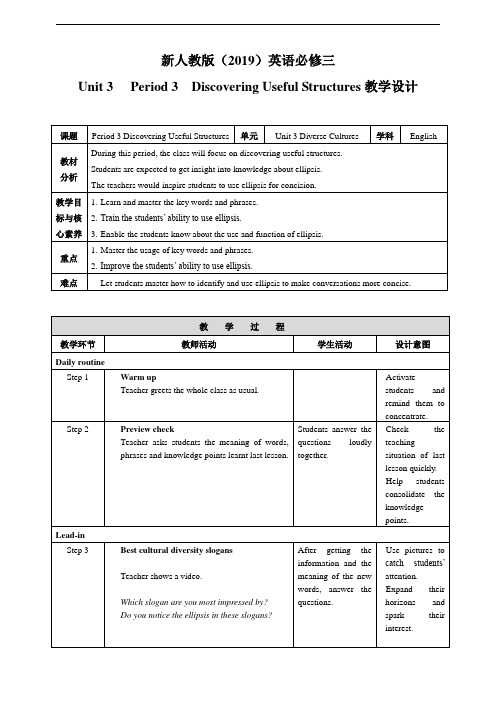
Linlin: And I strongly recommend the ethnic minority villages. You'll find Chinese culture is much more diverse than you thought.
2.He tried to solve his financial problems, but he couldn’t solve the problems.
3.If it is necessary, I’ll finish my report on American poetry as soon as it is possible.
Linlin: Wow, that’s cool! Guizhou is a province with a lot of cultural diversity. Places to visit... well, definitely the Huangguoshu Waterfall first.
5.Some wild mushrooms arc poisonous and some are not.
6.I really like that paper folding book, and my son, too.
Read the conversation. Find out which words have been left out.
Justin: Sounds great, thanks!
Keys:
Justin: Linlin, I'm going to Guizhou Province next month. I'm super excited! Any recommendations for places to visit?
必修三unit3 教案
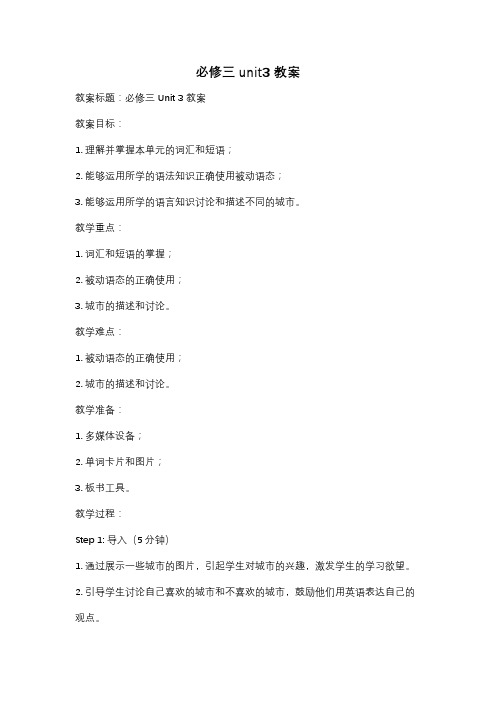
必修三unit3 教案教案标题:必修三 Unit 3 教案教案目标:1. 理解并掌握本单元的词汇和短语;2. 能够运用所学的语法知识正确使用被动语态;3. 能够运用所学的语言知识讨论和描述不同的城市。
教学重点:1. 词汇和短语的掌握;2. 被动语态的正确使用;3. 城市的描述和讨论。
教学难点:1. 被动语态的正确使用;2. 城市的描述和讨论。
教学准备:1. 多媒体设备;2. 单词卡片和图片;3. 板书工具。
教学过程:Step 1: 导入(5分钟)1. 通过展示一些城市的图片,引起学生对城市的兴趣,激发学生的学习欲望。
2. 引导学生讨论自己喜欢的城市和不喜欢的城市,鼓励他们用英语表达自己的观点。
Step 2: 词汇和短语学习(15分钟)1. 分发单词卡片,让学生阅读并尝试发音。
2. 通过图片或实物展示,解释单词的意思。
3. 引导学生进行词汇和短语的搭配练习,例如:“traffic jam”,“skyscraper”等。
Step 3: 语法学习(20分钟)1. 通过多媒体展示被动语态的用法和结构,并解释其基本规则。
2. 给学生提供一些例句,让他们尝试将主动语态转换为被动语态。
3. 给学生一些练习题,让他们巩固被动语态的用法。
Step 4: 阅读和讨论(20分钟)1. 分发阅读材料,让学生阅读有关不同城市的文章。
2. 引导学生进行小组讨论,让他们分享自己对不同城市的看法和观点。
3. 鼓励学生使用被动语态和所学的词汇和短语来描述和讨论城市。
Step 5: 总结和作业布置(5分钟)1. 总结本节课所学的内容,强调被动语态的正确使用和城市描述的技巧。
2. 布置作业:要求学生写一篇关于自己所在城市的短文,使用被动语态和所学的词汇和短语进行描述。
教学反思:通过本节课的教学,学生能够掌握本单元的词汇和短语,理解并正确使用被动语态,能够用英语进行城市的描述和讨论。
同时,通过小组讨论和写作作业,学生的口语和写作能力也得到了提高。
最新高一英语新课标人教版必修3unit3教学设计(3)名师优秀教案

高一英语新课标人教版必修3unit3教学设计(3)2012-2013英语必修3人教版新课标Unit 3金牌教学设计(3)Unit 3 The Millin Pnd Bank NtePart 1 Teahing Deign第一部分教学设计Perid 3 A aple len plan fr Uing Langage(THE MILLION POUND BAN NOTE)IntrdtinLangage i learned t be ed in and fr niatin S in thi perid we hall have the tdent read, liten, write and peak in Englih, aking e f the fed wrd, exprein, trtre and tpi idea vered in thi nit Waring p by litening and reading ald t the tape rerding i t be fllwed by litening and peaking Reading i dne by having tdent reading and ating,reading and nderlining And writing i t be dne by tdent litening and writing,reading and learning,writing a play r draa The la end by tdent ating t the play ObjetiveT learn re abt the try by reading the paage THE MILLION POUND BAN NOTET at t thi partT learn t e the langage by reading, litening, peaking and writing Predre1 Waring p by litening and reading ald t the tape rerdingWar p by litening and reading ald t the tape rerding f ACT ONE, Sene 4 f THE MILLION POUND BAN NOTE第 1 页共 4 页2 Reading and atingRead the play firt, and then try t at it t in grp 3 Reading and nderliningNext y are t read areflly and write in yr nte bk all the efl exprein r llatin fr the paageCllatin fr ACT ONE, Sene 4 f THE MILLION POUND BAN NOTEtide a retarant(在餐馆外边), lk at the envelp with the letter(看着那封信的信封), it dwn at the table(坐在桌旁), next t…(靠近,紧挨着), ee b’ appearane(看某人的外表), take ne’ rder(来等……点菜), a nie bigteak(一块大牛排), ake… extra thik(使……特别厚), t a tiny bit(得多花点儿钱), have a nie tall la f beer(要要一大杯啤酒), leave fr…(朝……走去), eat like a wlf(吃东西像头饿狼),a lever a a wlf(像狼一样机灵),lk n b’ fae (看着服务员脸上的神色),ak fr…(要……), take a hane(抓住机会,冒险), read the bill(念账单), tw rder f…(两份……),in a rde anner(以粗鲁的方式), take are f…(照看,照料,照应), a wnderfl eal(一顿美食),get … t f…(从……中得出……), pay the bill(付账), hld… in ne’ hand(手里拿着……), lk at… ver ne’ hlder(把头转向……看), ie a nte in the ant f…(发行了面值…的钞票), give attentin t…(对……注意,关注……), diver… fr the firt tie(如梦初醒,第一次发现/觉察到), hit b’ ar(打某人的手臂), pt…in the bak f …(把……带到……的后面), hange the banknte(找不开这张钞票), drein an nal way(穿着奇怪), a fr…(至于说……), thank… fr ne’heart(从心底里感谢……)4 Litening and writingNw y are ging t d exerie n page 23 fllwing the artile Writing a play r draa—PlaywritingEveryne ha at leat ne idea fr an epide f their favrite hw Intead f a try abt yr favrite hw, why nt trn itint a play fr y and yr friend! Trn t page 23 and write a play a reqired Y ay read the fllwing fr help(用原版)Here' hw t write a play1. Pik the harater and the latin the atin i taking plae Try ing jt three r fr harater fr the hw2. Deide what y want t happen t the harater Are they n a treare hnt? Are they pending theafternn at the beah? Are they trying t lve a prble? Y deide3. Che the ain harater f the play Thi i the pern wh the play i abt He keep the try ging第 2 页共 4 页4. On a piee f paper, write the nae f the harater, the latin, and the bai try5. Start writing the dialg It'll lk ething like thi: Main Charater: Say thi Friend: Say that OtherFriend: Say ething ele Main Charater: Finih the nveratin6. Make the atr ve Write in ething like thi: (Main Charater enterthe kithen fr tide)7. Add prp that fit the atin, h a a beah ball and twel fr a beah ene8. Reah a gd nlin t the atin9. Prf read the play Crret pelling, graar Add idea10. Ak e friend t play the part11. Pt it n fr yr faily and friend12. If y think it' really great, end it in t ne f the kid' variety hwTip:1. Read it and read it again, then read the play again Give it t ene ele t read fr idea fr what theatr ay t eah ther2. If y think y're better at writing hrt trie than play, g ahead and hange it t a hrt try!3. Sbit the play r try t ne f the kid variety r reading hw6 Learning t ating and direting?T learn ating and diretingLet e tell y what i iprtant t yr ating, that, y knw hw t play the gae t win nw what try y are tellingAtr think f aeDiretr think f reltIn the he f entertainent the atr and diretr have t erve the adiene and wrk fr the athr ?Defining AtingThe priniple f ating e fr all the thing y d in lifeThe atr ha t learn all the ating priniple, then the priniple have t bee bliinal in their atingWrk n yr ating raft in an ating wrkhp: jt knw the line and d the ene It i really that iple7 Cling dwn by ating the text第 3 页共 4 页Hell and Wele! Thi i the lb fr atr and atree f all age t e and wap ating idea, tip, r anything ele relating t any type f ating I hpe y will enjy yrelf here!Atr and atree fr r lb are ging t at t THE MILLION POUND BAN NOTE 第 4 页共 4 页。
高一英语教案:必修三Unit3教案

A Teaching PlanUnit 3 The Million Pound Bank-NoteWarming up and ReadingTeaching aims and demands:*Knowledge aims:1. To learn some words and expressions.2. To make sure the students have a full understanding of the text.3. To guide the students to have a discussion about the characters in the text .4. To get the students to know more about a play by reading and acting.*Ability aims:1. To cultivate the students’ reading ability.2. To cultivate the students’ oral English skills and related knowledg e about a play by discussion and acting.*Moral aims:1. To enable the students to know more about the quality of capitalist society and to educate them to love our country more.2. To educate the students to work together to finish some tasks.3. To arous e the students’ interest in learning English through various activities in class.Teaching important points:1. To make the students have a full understanding of the text.2. To make the students know more about a play by discussion and acting. Teaching difficult points:1. To improve the students’ reading ability.2. To enable the students to voice their opinions freely.Teaching materials:1. The videos of the film clips.2. Some related pictures.3. A tape of the text.Teaching aids:1. Multi-media facilities.2. A recorder.Teaching methods:1. Asking-and-answering method.2. Discussing method.The title : Unit 3 The Million Pound Bank-NoteSome words and phrases: a large amount of ; millionaire ; make a bet (on sth.) ; land (v.); bay ; jealous ; character ; “fact” and “opinion”附: 马克• 吐温的格言警句1. The man who does not read books has no advantage over the man that cannot read them.2. Always tell the truth; then you don’t have to remember anything.3. When people do not respect us we are sharply offended; yet deep down in his private heart no man much respects himself.4. Good breeding consists in concealing how much we think of ourselves and how little we think of the other person.。
人教版高中英语必修三《Unit3 XXX Note》教学设计

人教版高中英语必修三《Unit3 XXX Note》教学设计The n Pound Bank Note Act 1.Scene 3XXXXXX: People'XXX Curriculum StandardGrade: Grade 11Module: Module 3 (Compulsory)XXX: Unit 3 Reading Lesson 2 (45 minutes)XXX: XXXXXX: XXXTextbook AnalysisThe main content of this unit is several XXX's novel "The n Pound Bank Note"。
From the perspective of topic content and n。
Warming up。
Pre-reading。
and Reading (Act 1.Scene 3) are XXX。
1) "Warming up" provides a brief n to Mark Twain。
and through the n of Mark Twain and his works。
it arouses students' interest and XXX his works.2) "Pre-reading" requires students to watch a video and XXX.3) "Reading" is Act 1.Scene 3 of the play。
Two XXX on what will happen to a poor and honest man after he receives a n pound bank note。
They find Henry Adams。
- 1、下载文档前请自行甄别文档内容的完整性,平台不提供额外的编辑、内容补充、找答案等附加服务。
- 2、"仅部分预览"的文档,不可在线预览部分如存在完整性等问题,可反馈申请退款(可完整预览的文档不适用该条件!)。
- 3、如文档侵犯您的权益,请联系客服反馈,我们会尽快为您处理(人工客服工作时间:9:00-18:30)。
教学过程一、课堂导入以提问的形式,提问学生对马克·吐温和他的作品的了解,并做简单的介绍。
二、复习预习教师引导学生复习上节课所学知识点,(以提问、回顾的形式进行),针对上节课的作业进行讲评、订正、答疑,并通过对宾语从句具体用法的分析和扩展导入本节课所要学习的课本知识的学习。
三、知识讲解考点/易错点1 重点单词与短语学习bring up 培养;抚养;养育或教育某人;提出(回归课本P17)He was brought up in Hannibal.Eg: She brought up five children. 她养育了五个孩子。
Her parents died when she was a baby and she was brought up by her aunt.[归纳拓展]bring sb. up to be/as 培养某人成为bring sb. up to do sth. 培养某人要……bring about 带来,造成;使(船等)掉过头来bring back 带回来,拿回来;使回忆起来;使恢复bring down降低,使下降,使倒下bring in 收割(庄稼等);生产,产出;挣得;引进/来bring out 出版,生产;拿出,取出;说出;使显出,使(意义)明白表达出来bring……to a close/ an end结束,使完结bring……to a stop使停止,使停住scene n. 场面;情景;景象;事件(回归课本P17) Act 1 ,scene 3.[归纳拓展]辨析:scene / sight / view / sceneryscene 指某一处的自然风光,指展现在眼前的情景,也可指scenery的一部分;指某处小范围的景色,大多包括景物中的人及活动,可译为“情景”、“景色”、“场面”、“(戏剧)一场”。
scenery(总称)自然景物,天然风光,是由多个scenes构成的自然风景。
sight 景象,风景,名胜;视力/眼界,是眼睛所看到的景象,可以指美丽的风景,也可以指悲惨的景象,用其复数sights表示名胜古迹,人文景观等。
view 景色,风景,是指人以一定的角度(或从远处或从高处等)所看到的景色;还有“观点”“看法”的意思。
【练习】根据句子意思用scene,sight,view,scenery的适当形式填空。
1). Guilin is famous for its beautiful _______.2). The _______ is a perfect dream when you see the sun rising slowly in the east.3). You can get a wonderful _______at the top of the tower.4). The flowers are a lovely _______ in spring.5). He began to lose his _______six years ago.Keys: 1). scenery 2). scene 3). view 4). sight 5). sightbet n. 打赌,赌注;被打赌的事物vt. 打赌;敢断定,确信(回归课本P17)Two old and wealthy brothers,Roderick and Oliver,have made a bet.Eg: He often bets a 1ot of money on horses. 他经常在赛马上豪赌。
I bet that it will rain tomorrow. 我敢肯定说明天一定会下雨。
[归纳拓展]bet on sth为某事打赌bet sb. + 赌注on sth 用赌注就某事与某人打赌make a bet on 为某事打赌win/lose a bet 打赌赢/输了permit v. 允许,许可;n.表具体含义“通行证,许可证,执照” [C](回归课本P18 Line 3)Permit me to lead the way,sir.[归纳拓展]permission n. 表抽象含义“允许,许可” [U]permit sth. / doing sth. 允许做某事permit sb. to do sth. 允许某人做某事permit sb. sth. 允许某人某物give sb. a permission to do sth. 给某人做某事的许可ask (sb.) for permission 请求某人许可with / without one’s permission没有某人的许可eg:Visitors are not permitted to take photos.游客请勿拍照。
Time/Weather permitting (=If time/ weather permits),I’ll come tomorrow.如果天气许可的话,我明天来。
I don’t permit holding a party in my house. 我不允许在我的房子里开晚会。
Jim’s father didn’t permit him to join the school football team.吉姆的父亲不允许他加入校足球队。
The doctor has permitted him only two meals a day. 医生只允许他一天吃两顿饭。
【辨析】let,permit,allowlet允许,让,常用于口语中,一般不用于被动语态。
后接不带to的不定式作宾补。
permit v. & allow v. 在许多情况下二者可以通用,但:permit更正式、积极,多指上级对下级或长辈对晚辈的准许,语气较强;有“主动许可、正式批准”之意。
词义较强allow偏重听任或默许,多指听任或不管教某人做某事。
有并不反对或不加阻止的含义,词义较弱。
常用句型allow/permit sb. to do sth.be allowed/permitted to do sth.allow/permit doing sth.eg:The nurse allowed him to remain there,though it was not permitted.go ahead执行,进行,前进,(于祈使句)可以,往下说,用吧,开始吧(回归课本P18 Line 23)Go right ahead.Eg: Despite the bad weather,the journey will go ahead. 尽管天气不好,旅行将照常进行。
The building of the new bridge will go ahead as planned.新桥的修建将按计划进行。
[归纳拓展](be) ahead of 在之前;领先于;胜过ahead of time / in advance 提前go after追求;设法获得go against反对;不利于go along和…一道;往前走go away走开;离开go by走过,经过go for接(某人);去做(某事);努力获取go off爆炸;(灯)灭了go out外出;(灯,火)熄灭go over仔细检查;复习go through浏览;翻阅;遭受,经历go up上升,上涨go without 没有go wrong走错路;出毛病as a matter of fact 事实上(回归课本P18)As a matter of fact,I landed in Britain by accident.as a matter of fact 相当于in fact,actually。
意为“事实上,其实”eg: as a matter of fact,the crop circles in England were men-made.by accident 偶然地;意外地(回归课本P18)As a matter of fact,I landed in Britain by accident.by accident = by chance表示“偶然地,意外地”,在句中作状语。
Eg: Last time I ran across her in the street by accident. 上次我偶然在街上碰见她。
I only found it by accident. 我只是碰巧找到的。
[归纳拓展] by + n. 短语by contrast 对比之下by mistake 错误地by hand 用手,用体力by machine 用机器spot v. 发现。
(回归课本P18)The next morning I’d just about gi ven myself up for lost when I was spotted by a ship. 【名师点拨】句中的spot是及物动词,表示“发觉;找出”,其后可接that从句。
He spotted a friend in the street and went over to her.No one spotted that the bank-note was fake.Neighbors spotted smoke coming out of the house.【归纳拓展】spot sb. doing sth. 看到某人正在做某事on the spot = on the scene到(在)现场;当场spot还可以用作名词,表示“污点;地点”。
Eg:How can I get rid of the spots on my clothes?passage n. 通道;(书、讲话、音乐等的)一段,一节;经过,通过,消逝;旅费account for导致;做出解释;总计有(回归课本P18)The fact is that I earned my passage by working as an unpaid hand,which accounts for my appearance.passageEg: They were denied passage through the occupied territory. 他们被禁止穿越占领区。
He worked his passage to Australia. 他在去澳大利亚旅行的船上做工偿付船费。
[归纳拓展]with the passage of time 随着时间的推移account for表示“解释,说明”,在含义上相当于explain。
